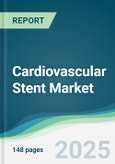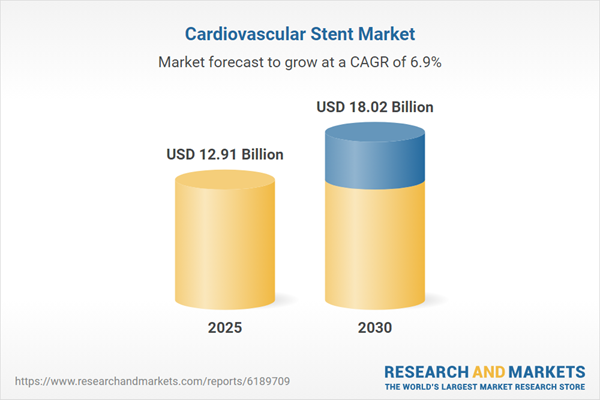The global cardiovascular stent market is poised for growth, driven by the rising prevalence of cardiovascular diseases and an aging population requiring interventions for coronary artery blockages. These stents restore blood flow in narrowed or blocked arteries, reducing risks of heart attacks and strokes, thereby improving patient quality of life. However, challenges such as the risk of blood clot formation post-stent placement and the availability of alternative treatments like bypass surgery pose significant constraints to market expansion.
Market Drivers
Rising Cardiovascular Disease Prevalence
The surge in cardiovascular diseases, the leading global cause of death, significantly drives demand for cardiovascular stents. The World Health Organization reports that these diseases account for 32% of annual deaths worldwide, equating to approximately 17.9 million fatalities. In the United States, the Centers for Disease Control and Prevention note that 655,000 deaths occur annually due to heart-related issues, while in Australia, cardiovascular conditions affect over 4 million people, claiming 118 lives daily. Lifestyle factors, including stress, poor dietary habits, and sedentary work cultures, exacerbate these conditions, increasing artery blockages and the need for stents to restore blood flow. This trend is expected to fuel market growth through 2030 as the incidence of cardiovascular issues continues to rise.Growing Geriatric Population
The expanding geriatric demographic is a key market driver, as older individuals are more prone to cardiovascular conditions requiring stents for effective blood flow management. The United Nations projects that the global population aged 65 and above will reach 15% by 2050, up from 9.5% in 2020. This demographic shift heightens the demand for stents, as age-related artery failures necessitate interventions to maintain cardiovascular health, significantly contributing to market expansion.Market Constraints
Risk of Blood Clots and Alternative Treatments
A major limitation is the risk of blood clot formation post-stent implantation, which can disrupt blood flow and elevate the risk of heart attacks or strokes. Research indicates that 1-2% of stent recipients develop clots, particularly in the initial months post-procedure, with risks persisting long-term despite preventive measures. Additionally, alternative treatments like bypass surgery challenge market growth. For patients with multiple artery blockages, bypass surgery is often recommended over stents due to lower clot risks and better long-term outcomes. A study by the American College of Cardiology found that 29.87% of stent patients died within 10 years compared to 24.7% of bypass surgery patients, with stroke or heart attack due to clots as the primary cause. Furthermore, 16.1% of stent patients required a second procedure, compared to 8% for bypass patients, highlighting bypass surgery’s superior efficacy.Market Outlook
The cardiovascular stent market is set to grow through 2030, driven by increasing cardiovascular disease prevalence and an aging population. However, the risk of clots and competition from bypass surgery necessitate advancements in stent technology to enhance safety and efficacy. Stakeholders must focus on innovation to address these challenges and capitalize on the growing demand for minimally invasive cardiovascular solutions.Key Benefits of this Report:
- Insightful Analysis: Gain detailed market insights covering major as well as emerging geographical regions, focusing on customer segments, government policies and socio-economic factors, consumer preferences, industry verticals, and other sub-segments.
- Competitive Landscape: Understand the strategic maneuvers employed by key players globally to understand possible market penetration with the correct strategy.
- Market Drivers & Future Trends: Explore the dynamic factors and pivotal market trends and how they will shape future market developments.
- Actionable Recommendations: Utilize the insights to exercise strategic decisions to uncover new business streams and revenues in a dynamic environment.
- Caters to a Wide Audience: Beneficial and cost-effective for startups, research institutions, consultants, SMEs, and large enterprises.
What do businesses use our reports for?
Industry and Market Insights, Opportunity Assessment, Product Demand Forecasting, Market Entry Strategy, Geographical Expansion, Capital Investment Decisions, Regulatory Framework & Implications, New Product Development, and Competitive Intelligence.Report Coverage:
- Historical data from 2022 to 2024 & forecast data from 2025 to 2030
- Growth Opportunities, Challenges, Supply Chain Outlook, Regulatory Framework, and Trend Analysis
- Competitive Positioning, Strategies, and Market Share Analysis
- Revenue Growth and Forecast Assessment of segments and regions including countries
- Company Profiling (Strategies, Products, Financial Information, and Key Developments among others)
Market Segmentation:
- By Type
- Dual Therapy Stent
- Bare Metal Stent
- Drug Eluting Stent
- Others
- By Material
- Polymers
- Metal
- Stainless Steel
- Cobalt Chromium
- Others
- By End-User
- Hospitals
- Ambulatory Surgical Centers
- Others
- By Geography
- North America
- USA
- Canada
- Mexico
- South America
- Brazil
- Argentina
- Others
- Europe
- Germany
- France
- United Kingdom
- Spain
- Others
- Middle East and Africa
- Saudi Arabia
- UAE
- Israel
- Others
- Asia-Pacific
- China
- India
- Japan
- South Korea
- Indonesia
- Thailand
- Taiwan
- Others
- North America
Table of Contents
Companies Mentioned
- Major Players and Strategy Analysis
- Market Share Analysis
- Mergers, Acquisitions, Agreements, and Collaborations
- Competitive Dashboard
- COMPANY PROFILES
- Abbott Laboratories
- Medtronic
- Boston Scientific Corporation
- B. Braun
- Terumo Corporation
- BIOTRONIK SE & Co. KG
- MicroPort Scientific Corporation
- Translumina
- Integer Holdings Corporation
- HEXACATH
Table Information
| Report Attribute | Details |
|---|---|
| No. of Pages | 148 |
| Published | November 2025 |
| Forecast Period | 2025 - 2030 |
| Estimated Market Value ( USD | $ 12.91 Billion |
| Forecasted Market Value ( USD | $ 18.02 Billion |
| Compound Annual Growth Rate | 6.8% |
| Regions Covered | Global |
| No. of Companies Mentioned | 15 |









